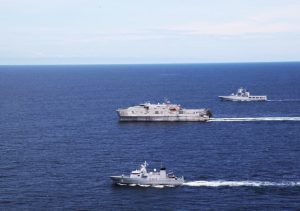India and Russia are set to sign a bilateral military logistics agreement in the coming months. The India-Russia bilateral agreement is called the Reciprocal Exchange of Logistics Agreement (RELOS), similar in title to an India-U.S. agreement called the Logistics Exchange Memorandum of Agreement (LEMOA). Like all logistics service agreements, the RELOS is meant to be a reciprocal arrangement by which the two nations can use the military logistics facilities while on visit to each other’s ports, bases, and military installations.
It took a decade for India to debate the pros and cons of signing such an agreement with the United States, but since the signing of the LEMOA, India has become more comfortable in concluding such arrangements with other countries. Today, India has such military logistics agreements with Australia, Japan, the United States – the Quad countries – as well as with France, Singapore, and South Korea. India is currently in the process of finalizing such an agreement with the U.K. and in talks with other partners like Vietnam.
These agreements go a long way in expanding India’s military reach, especially maritime outreach and influence in various regions that are strategically important to India. On a practical note, it saves enormous time and reduces overall costs of the lengthy bookkeeping exercises that the militaries have to otherwise do with each visit, such as when the respective militaries are involved in operations like humanitarian assistance and disaster relief or even bilateral military exercises.
Military logistics agreements are merely administrative arrangements between strategic partners that would facilitate replenishment of fuel, rations, and spare parts, as well as berthing and maintenance for each other’s warships, military aircraft, and troops during port visits and joint exercises, on a reciprocal basis, essentially simplifying the process of extending logistical support to one other.
Being the most outgoing force of the three services, the Indian Navy has benefited the most from these logistics pacts. These agreements have enhanced operational turnaround and strengthened interoperability among partner navies on the high seas. For example, around the time Australia was working out the details of a logistics agreement with India, one diplomatic source highlighted the handicaps that come without an agreement, giving as an instance a previous “ship-to-ship refueling exercise between the two navies ‘ended out to be a dummy exercise as we couldn’t actually pass fuel as we did not have a logistics agreement.’”
Commenting on the usefulness of these agreements with like-minded partners, Commodore Anil Jai Singh, a maritime analyst, pointed out that in the last few years, “the Indian Navy has adopted a multi-mission deployment with 12-15 IN warships operating independently across the Indo-Pacific to monitor the critical chokepoints bordering the Indian Ocean, ensure the safe passage of trade, enhance maritime domain awareness, provide humanitarian assistance and disaster relief, combat non- traditional and sub-conventional security threats and a host of other functions. It is not possible for each ship to be accompanied by a logistic support ship – the availability of logistic and maintenance support in friendly ports is therefore essential for the success of such deployments.”
Initially expected to be signed during Prime Minister Narendra Modi’s visit to Russia for the Eastern Economic Forum in Vladivostok in 2019, the bilateral logistics agreement has seen several delays, but the RELOS is now expected to be signed during the visit of Russian Defense Minister Gen. Sergei Shoigu in the coming months. Shoigu will be in India to co-chair the Inter-Governmental Commission meeting which deals with a range of military technical cooperation between India and Russia. During the visit, the two countries will also sign a navy-to-navy cooperation MoU.
According to media reports, the India-Russia RELOS will give India access to Russian military facilities in the Arctic region. Similarly, each of the military logistics agreements that India has signed with like-minded partners extend India’s maritime and strategic reach and influence in the Indian Ocean and beyond. The LEMOA for instance provides India refueling facilities and access to U.S. military facilities in Djibouti, Diego Garcia, Guam, and Subic Bay. There have already been instances of practical cooperation between India and the U.S. under the LEMOA.
Similarly, India’s agreement with France extends New Delhi’s reach into the southwestern Indian Ocean region, where the French have a military presence, and thus access to the Reunion Islands near Madagascar and Djibouti. India’s agreement with Australia expands Indian outreach into the southern Indian Ocean as well as the Western Pacific. These are critical, particularly after China set up its first military base in Djibouti in 2017. Also, as India continues to rise, its requirements to go farther out into the seas and not just be not confined to immediate waters around India also expand. This has already permitted India to undertake a number of mission-based deployments in the Indian Ocean region and the broader Indo-Pacific.
India shied away from concluding military logistic agreements for more than a decade. But China has facilitated India’s embrace of like-minded partners across the Indo-Pacific, including through logistics agreements.

































